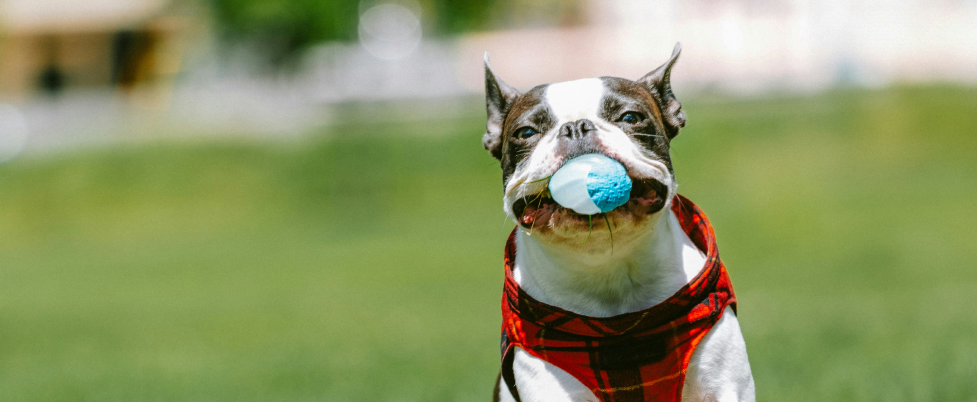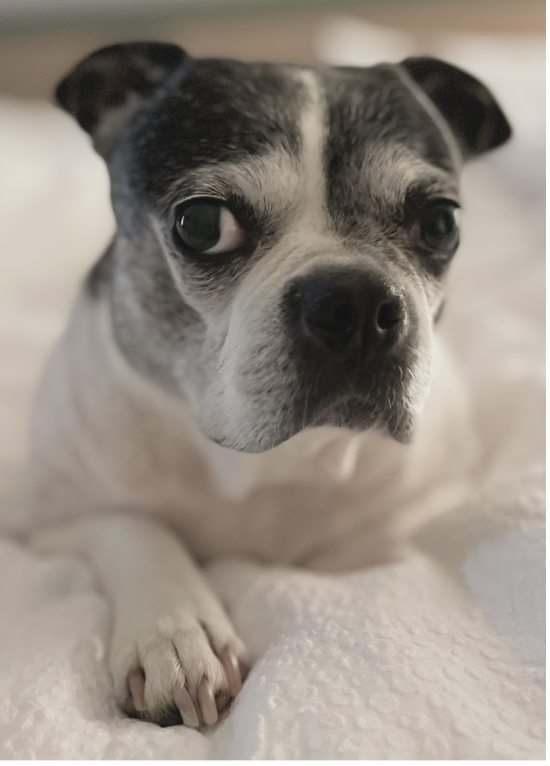THE CARE CORNER / HEALTH HACKS

Disclaimer: I am not a veterinarian. The information provided here is for general knowledge and educational purposes only. Please consult your vet for any health concerns about your Boston Terrier.
Do Boston Terriers have breathing problems?
Yes, Boston Terriers, with their adorable flat faces, can have breathing problems because of their brachycephalic nature. Their flat facial structure can compromise their airways and restrict their breathing.
Understanding how to help your Boston breathe easier is essential to their health and well-being. In this guide, we’ll explore common breathing problems, prevention tips, and practical steps you can take to support your Boston’s respiratory health.
1. What is Brachycephalic Airway Syndrome?
Brachycephalic airway syndrome refers to the breathing difficulties faced by dog breeds with short, flat snouts, like Boston Terriers. Also known as brachycephalic obstructive airway syndrome (BOAS), this condition affects the nose, throat, and airways, making it harder for them to breathe.
Common symptoms of brachycephalic syndrome include:
- Snoring
- Wheezing or noisy breathing
- Exercise intolerance
- Sniffing or mouth breathing
Why does my Boston Terrier gasp for air?
Boston Terrier flat faces lead to a smaller upper airway, which can cause both breathing and heat regulation problems. Keeping an eye on their breathing habits is key to their health.
2. Common Boston Terrier Breathing Issues
Boston Terriers may face several breathing problems, including:
- Nasal Congestion: Blocked airways can cause breathing difficulties.
- Reverse Sneezing: Often caused by irritants or excitement, it’s common but usually harmless.
- Collapsed Trachea: A more serious issue where the windpipe weakens, leading to difficulty breathing.
- Laryngeal Collapse: Usually a secondary condition caused by BOAS.
Signs to Watch For:
Keep an eye out for any signs of distress like excessive panting, labored breathing, or coughing.
3. How to Improve Breathing Difficulties and Help Your Boston’s Snout
Regular Vet Check-ups
Routine vet visits are essential for detecting and treating any breathing issues early. Your vet will check for any abnormalities in your Boston’s airways and suggest treatments if necessary.
Keep Your Boston’s Weight in Check
Overweight dogs are at greater risk of breathing problems. Maintain a healthy weight through proper diet and regular exercise.
Ensure Proper Grooming
Keeping your Boston’s face clean can help prevent nasal congestion. Regularly wipe away any discharge from their eyes or nose, as this can contribute to breathing difficulties.
Tip: Use soft, damp cloths to clean their faces gently, avoiding harsh rubbing.
Provide a Cool Environment
Boston Terriers are sensitive to heat, and the heat can make breathing problems worse. Keep them in a cool environment and avoid heavy exercise on hot days.
Tip: If you’re outside with your Boston on a warm day, offer them fresh water and shade regularly.
Consider Using a Humidifier
Dry air can irritate your Boston’s respiratory system. A humidifier in your home can help keep their nasal passages clear, especially during the winter when the air tends to be drier.
Tip: Place a humidifier in areas where your dog spends most of their time, like the living room or bedroom.
Don’t Over-Exercise
While exercise is important, Boston Terriers can easily become overexerted due to their breathing difficulties. Keep playtime short and be mindful of how they’re breathing.
Tip: Short walks and gentle play are best.
4. Foods and Supplements for Respiratory Health
Foods that Support Breathing:
Certain foods can promote a healthy airway and improve your Boston’s overall well-being:
- Omega-3 Fatty Acids: These can reduce inflammation and improve respiratory health. Look for food with salmon or fish oil.
- Antioxidants: Foods rich in antioxidants, like blueberries, can boost your Boston’s immune system.
Supplements to Considers
Consult your vet about supplements that might help with breathing, such as glucosamine for joint health and fish oil for reducing inflammation in the airways.
5. When to Seek Professional Help
If your Boston’s breathing issues seem more severe or don’t improve with lifestyle changes, it’s time to visit the vet. Look out for signs like:
- Persistent coughing or wheezing
- Blue gums or tongue (a sign of lack of oxygen)
- Difficulty sleeping due to breathing problems
Don’t wait—getting your Boston the help they need quickly can prevent more serious health issues.
6. Breathing Solutions: Medical Interventions
If your Boston has a serious breathing problem, medical intervention might be necessary. Treatments could include:
- Surgery: In some cases, surgery may be required to correct airway issues like a collapsed trachea or elongated soft palate.
- Medications: Your vet may recommend medications to reduce inflammation or help manage any respiratory conditions.
Always discuss medical options with your vet before making decisions.
7. How to Prevent Breathing Problems in Your Boston Terrier
How to Be Proactive
Preventing breathing problems starts with the right care and attention to your Boston’s overall health. Here are a few additional tips:
- Avoid environmental triggers: Things like smoke, strong scents, or allergens can worsen your Boston’s breathing.
- Keep their face clean and free from irritants: Regularly clean around their nose and eyes.
- Watch for changes in behavior: If you notice any unusual behavior, like labored breathing or changes in activity level, don’t ignore it.
Conclusion: Helping Your Boston Terrier Breathe Easy
Boston Terriers are lovable companions, and their health and well-being are important. By understanding their unique breathing needs and following the tips outlined here, you can help ensure that your Boston’s snout stays happy and healthy. Remember, always consult with a veterinarian for personalized advice, especially if your dog shows signs of breathing distress.

While Boston Terriers can face some health challenges, with the right care, you can help them stay happy and comfortable.
Start with our general grooming guide to cover basics.
For skin health, keeping their coat smooth covers how to prevent dryness and irritation.
Since eye problems are common in the breed, make sure to check out our eye health guide to learn about symptoms and care tips.
And if allergies are affecting your Boston, our article on what to know about Boston Terrier allergies will help you identify triggers and find relief for your pup.
FAQ
Q: Is snoring normal for Boston Terriers?
Yes, snoring is common for brachycephalic dog breeds like Boston Terriers, but if it’s accompanied by signs of distress, it’s important to consult a vet.
Q: What should I do if my dog starts reverse sneezing?
If your dog begins reverse sneezing, try gently holding their nostrils closed for a second and lightly massaging their throat. This can encourage them to swallow and stop the spasm. You can also try lightly blowing in their face, which may help interrupt the sneezing episode. Stay calm and reassure your dog with gentle words and pets. These simple steps often resolve the issue quickly.
Based on advice from the American Kennel Club
Q: Why should I use a harness instead of a neck collar for my Boston Terrier?
Boston Terriers are prone to breathing difficulties, and a neck collar can put unnecessary pressure on their airway, potentially worsening respiratory problems. Using a harness for least walks helps eliminate neck strain and allows your pet to breathe more comfortably.
Q: Are certain types of muzzles unsafe for Boston Terriers?
Yes, some muzzle styles can impede breathing, which is especially concering for brachycephalic breeds like Boston Terriers. Avoid mesh or soft muzzles that might restrict airflow. Instead, opt for a basket muzzle if needed, and consult with your vet for recommendations tailored to your pet’s needs.
Q: How much exercise is appropriate for a Boston Terrier?
While Boston Terriers enjoy playtime, they’re not built for high-endurance activities like long runs or hikes. Instead, provide moderate exercise such as daily leash walks, games of fetch, gently swimming, or short dog park visits. This helps keep them fit without overexerting them.
Q: What should I do when it’s hot outside?
Boston Terriers struggle to cool down in hot weather due to their inefficient panting. To prevent heatstroke, keep them indoors in air-conditioning during high temperatures. Always prioritize their safety over outdoor activities on hot days.
Q: What are the warning signs of breathing problems in a Boston Terrier?
Signs of trouble include excessive panting, noisy breathing, gagging, exercise intolerance, a blue tongue or gums, or collapse. If you notice any of these symptoms, seek veterinary help immediately to ensure your pet’s safety.
Other articles by this author

“Hi! I’m Weezie, a spirited Boston Terrier / French Bulldog mix and self-proclaimed expert on everything Boston.
Want to keep your Boston Terrier looking and feeling their best?
Start with our general grooming guide to cover basics.
Check out our guide on keeping their coat healthy and beautiful. For tips on the best bath routine, head over to our Boston Terrier bathing guide. And don’t forget about ear and nail care—we’ve got a full breakdown to keep your pup well-groomed from head to toe!